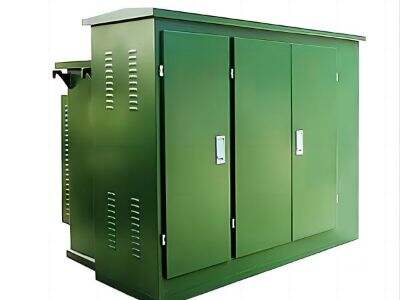Існуюць прафілактычныя меры і рэкамендацыі, якіх неабходна выконваць пры ўсталёўцы стацыянарных трансфарматараў. Гэтыя правілы забяспечваюць бесперабойную працу і бяспечнае абыходжанне з усімі. Выкананне некалькіх такіх простых крокаў дапаможа гарантаваць, што трансфарматар працуе належным чынам. Вось важныя вывады:
Пераканайцеся, што правады зазямлення знаходзяцца ў належным парадку: адзін з найбольш важных папярэдніх этапаў перад пачаткам працэсу ўстаноўкі - праверыць, ці знаходзяцца драты зазямлення ў парадку. Зазямленне дапамагае пазбегнуць электрычных пажараў і іншых небяспек, якія могуць узнікнуць пры няправільным падключэнні правадоў. Гэта адзіны выпадак, калі пры выкананні электрамантажных работ неабходна выконваць усе меры засцярогі і правілы бяспекі. Гэта забяспечыць бяспеку вас і навакольных падчас мантажу.
Прастора: Трансформеры патрабуюць дастатковай прасторы навокал, каб правільна функцыянаваць. Калі вакол трансфарматара не хапае месца, ён можа пачаць перагравацца, а гэта можа быць вельмі небяспечна. Калі занадта шмат цяпла, гэта можа выклікаць пажар ці нават спыніць працу трансфарматара. Такім чынам, пераканайцеся, што прастора адпавядае патрабаванням трансфарматара. Заўсёды звяртайцеся да кіраўніцтва па ўсталёўцы, каб даведацца пра неабходнае месца.
Паток паветра: паток паветра - яшчэ адзін вельмі важны фактар для трансфарматараў. Трансфарматары могуць перагравацца і выклікаць пажар, калі не хапае паветра. Такім чынам, вам трэба пераканацца, што ёсць шмат месца для цыркуляцыі паветра вакол трансфарматара - першая ідэя, каб пазбегнуць гэтага. Добрая вентыляцыя падтрымлівае трансфарматар у прахалодзе і ў добрым стане. Пераканайцеся, што нішто не перашкаджае патоку паветра.
Абарона ад экстрэмальных умоў надвор'я Трансфарматары павінны быць абаронены ад экстрэмальных умоў надвор'я, такіх як дождж, град, снег і г. д. Ён можа быць пашкоджаны, калі ён намакне або падвергнецца ўздзеянню суровага надвор'я. Нам трэба захоўваць трансфарматар у сухім і бяспечным месцы, дзе на яго не будзе ўплываць знешняе асяроддзе. Гэта гарантуе бесперабойную працу і працяглы тэрмін службы.
4 ключавыя крокі для ўстаноўкі
Крок 1: Падрыхтоўка да ўстаноўкі a 3 фазны трансфарматар Вось некалькі крокаў, якія дапамогуць пераканацца, што трансфарматар бяспечна і правільна ўсталяваны:
Падрыхтоўка: перад пачаткам працэсу ўстаноўкі неабходна падрыхтаваць усё неабходнае абсталяванне. Паклапаціцеся пра тое, каб у вас былі ўсе неабходныя прадметы, каб вы маглі выканаць усё заданне адразу без паўзы. Вы таксама павінны прачытаць інструкцыю па ўстаноўцы і тэхнічныя характарыстыкі з дапамогай мікраскопа.
Мантаж: Замацуеце трансфарматар на сваім месцы. Гэта вельмі важная частка ўстаноўкі. Уважліва выконвайце спецыфікацыі вытворцы, каб пераканацца, што трансфарматар усталяваны трывала і не можа аслабіцца. Добра замацаваны трансфарматар на зямлі больш бяспечны і лепш працуе.
Праводка: Праводка важная для працэсу ўстаноўкі. Выконваючы інструкцыі вытворцы і стандарты бяспекі, падключыць усе правады вельмі важна. Калі электраправодка зроблена няправільна, гэта можа прывесці да сур'ёзных праблем, такіх як выхад з ладу трансфарматара і нават да пашкоджання электрычным токам. Выкарыстоўвайце свой час з розумам і пераканайцеся, што вашы адказы правільныя.
Тэставанне: нарэшце, калі ўсё на месцы, прыйшоў час праверыць трансфарматар, каб пацвердзіць, што ён працуе належным чынам. Тэставанне важна для выяўлення памылак, перш чым яны перарастуць у больш сур'ёзныя праблемы. Калі вы сухі трансфарматар сутыкнуліся з праблемамі ў працэсе тэсціравання, вы можаце правесці дыягностыку або наняць спецыяліста для ліквідацыі любых праблем.
Важныя парады па тэхнічным абслугоўванні
Стацыянарны трансфарматар, які быў усталяваны, неабходна акуратна абслугоўваць. Рэгулярнае тэхнічнае абслугоўванне дапаможа прадухіліць праблемы ў далейшым. Вось некаторыя важныя парады па абслугоўванні, якія трэба памятаць:
Рэгулярна правярайце: Неабходна праводзіць рэгулярныя праверкі трансфарматара, каб выявіць магчымыя памылкі або праблемы. Рэгулярныя праверкі могуць дазволіць вам дыягнаставаць праблемы на ранняй стадыі, перш чым яны пазней ператворацца ў большы і больш дарагі рамонт. Разумна скласці графік гэтых праверак.
Змазка: каб пераканацца, што трансфарматары працуюць належным чынам, іх трэба змазваць. Абавязкова выконвайце рэкамендацыі вытворцы адносна змазкі. Плаўны рух дапамагае часткам трэцца адна аб адну, прадухіляючы знос.
Чысціня: Не менш важна падтрымліваць трансфарматар у чысціні. Бруд, пыл і смецце могуць назапашвацца з часам, таму трансфарматары таксама трэба рэгулярна чысціць. Калі трансфарматар ачышчаны, ён выконвае працэс, не пашкоджваючыся і не зношваючыся.
Рамонт па меры неабходнасці: Любыя пашкоджаныя або зношаныя часткі трансфарматара павінны быць неадкладна заменены. Рэгулярна замяняйце пашкоджаныя дэталі, каб пазбегнуць новых пашкоджанняў, і пераканайцеся, што трансфарматар працягвае працаваць эфектыўна. Гэта ключавы аспект правільнага ўтрымання.
Асноўныя рэкамендацыі па ўстаноўцы і абслугоўванні сістэмы зваротнага осмасу
Акрамя прыведзеных вышэй парад, некаторыя лепшыя практыкі па ўсталёўцы і абслугоўванні стацыянарных трансфарматараў.
Выконвайце правілы бяспекі: Невыкананне дзеянняў трансфарматар правільна можа быць надзвычай небяспечным. Заўсёды прытрымлівайцеся пратаколу ўстаноўкі, абслугоўвання і бяспекі, устаноўленага вытворцам. Гэта важна для падтрымання бяспекі для вас і іншых, хто ўдзельнічае ў працэсе.
Атрымайце дапамогу: калі на любым этапе вы адчуваеце тупік або збянтэжанасць адносна любога кампанента ўстаноўкі або кіравання трансфарматарам, не саромейцеся звяртацца па дапамогу да кваліфікаванага электрыка або тэхніка. Калі ў вас ёсць пытанні ці праблемы, заўсёды лепш звярнуцца па кансультацыю да спецыяліста.
Навучыце людзей тэхніцы бяспекі: раскажыце кожнаму работніку пра небяспекі, звязаныя з працай з трансфарматарамі, і пра тое, як іх прадухіліць. Гэта дазваляе вам пераканацца, што вы працуеце бяспечна і эфектыўна. Інфармацыя вельмі важная для таго, каб пазбегнуць няшчасных выпадкаў.
Парады экспертаў
Нарэшце, некалькі саветаў ад прафесіяналаў па ўсталёўцы і абслугоўванню трансфарматара:
Выкарыстоўвайце добрыя дэталі: Заўсёды выкарыстоўвайце дэталі добрай якасці ў вашым трансфарматары. Выкарыстанне правільных дэталяў дапамагае гарантаваць, што трансфарматар будзе працаваць бяспечна і эфектыўна, забяспечваючы надзейнае абслугоўванне.
Запісы па тэхнічным абслугоўванні: запісвайце ўсе дзеянні па ўстаноўцы і тэхнічным абслугоўванні. Дакументаваны запіс можа дапамагчы вам адсочваць прадукцыйнасць. Пісьмовы запіс можа дапамагчы выявіць патэнцыйныя праблемы і, з цягам часу, кантраляваць прадукцыйнасць трансфарматара і дапамагчы знайсці тэндэнцыі або пастаянныя праблемы.
Пераканайцеся, што злучэнні добрыя: стацыянарныя трансфарматары могуць сутыкнуцца са слабымі злучэннямі, што можа быць звычайнай праблемай. Вазьміце звычку перыядычна правяраць усе злучэнні і зацягваць тыя, якія могуць аслабіць. Гэты просты крок можа пазбавіць вас ад вялікіх галаўных боляў у будучыні.
Рэгулярнае тэсціраванне: вельмі важна праводзіць пастаянныя тэсціраванні, каб пераканацца, што трансфарматар працуе належным чынам. Акрамя таго, чаму б не праводзіць рэгулярныя тэсты, каб своечасова выявіць любыя патэнцыйныя праблемы, што зэканоміць ваш час і грошы ў доўгатэрміновай перспектыве?
Каб атрымаць дадатковую інфармацыю, вы можаце пракансультавацца з нашымі спецыялістамі адносна ўстаноўкі і тэхнічнага абслугоўвання стацыянарных трансфарматараў. Захаванне гэтых найважнейшых мер і рэкамендацый па тэхнічным абслугоўванні, добрых практык і рэкамендацый экспертаў дапаможа забяспечыць бяспечную і эфектыўную працу вашага стацыянарнага трансфарматара на працягу многіх дзесяцігоддзяў у будучыні.
 EN
EN
 AR
AR
 BG
BG
 HR
HR
 CS
CS
 DA
DA
 NL
NL
 FI
FI
 FR
FR
 DE
DE
 EL
EL
 HI
HI
 IT
IT
 JA
JA
 KO
KO
 НЕ
НЕ
 PL
PL
 PT
PT
 RO
RO
 RU
RU
 ES
ES
 SV
SV
 TL
TL
 ID
ID
 SR
SR
 UK
UK
 VI
VI
 HU
HU
 TH
TH
 TR
TR
 FA
FA
 AF
AF
 GA
GA
 CY
CY
 BE
BE
 BN
BN
 LA
LA
 MN
MN
 MY
MY
 UZ
UZ


